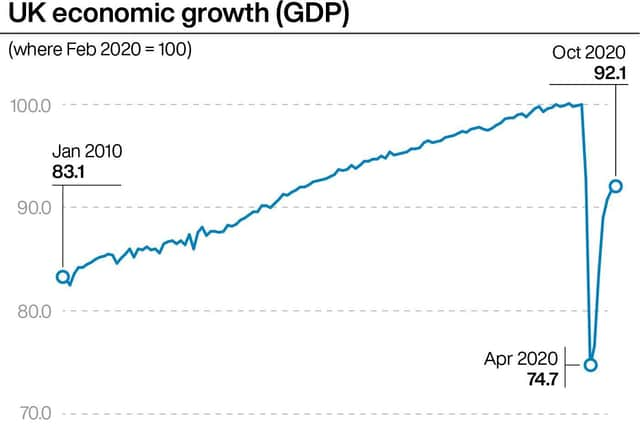Yorkshire to experience UK's slowest economic recovery from pandemic
The region’s Gross Value Added (GVA) levels and employment are both predicted to contract, with the region’s cities and larger towns to bear the brunt of economic pain.
The gloomy forecast comes in professional services giant EY’s latest Regional Economic Forecast in which it says Yorkshire’s GVA is expected to see the equivalent of an average annual decrease of 0.31 per cent between 2019 and 2023, whilst employment is expected to decline by 0.45 per cent a year over the same period.
Advertisement
Hide AdAdvertisement
Hide AdYorkshire is doubly impacted by having both a large manufacturing sector and a poorer share of sectors which are likely to be more resilient to the effects of Covid shutdowns, limiting its ability to offset contraction elsewhere in its economy.


The worst of the impact is expected to be felt in Yorkshire’s large towns and cities, although Sheffield, Leeds and York are likely to weather the storm better than elsewhere, EY said.
With employment in hospitality, back office services, the arts , leisure and manufacturing falling faster than the national average, cities in Yorkshire and Humberside and the Midlands were most affected due to their greater exposure to these sectors.
Suzanne Robinson, EY’s office managing partner for Yorkshire and the Humber, said: “Manufacturing, arts and leisure, and hospitality – crucial parts of the economies in towns, and the North – have been most affected during the pandemic or are likely to take longer to recover. These figures highlight the importance of ensuring this region continues to work on developing a balanced and mixed economy.”
Advertisement
Hide AdAdvertisement
Hide AdRelative sector performance is the main explanation for differences across cities.


Sheffield leads the region’s growth table with expected annual GVA growth of 0.16 per cent between 2019 and 2023, and the communication, health and social work sectors will record the biggest absolute increases in output over this period. Employment will fall slightly by 0.06 per cent per year.
Across many of the region’s towns the picture is less positive. Barnsley, Harrogate, Doncaster and Rotherham are expected to see GVA decline by the equivalent of an annual average of between 0.2 and 0.4 per cent over the period, with employment falling by around 0.5 per cent a year for all four.
The city of Hull is expected to experience the region’s greatest contraction from 2019 to 2023, with GVA expected to fall an average of 0.52 per cent a year to 2023 from 2019, and employment is forecast to decline by 0.65 per cent a year over the same period.
Advertisement
Hide AdAdvertisement
Hide AdNationwide, only the South East and London are forecast to employ more people in 2023 compared to 2019.


Ms Robinson said Hull’s reliance on manufacturing - some 27 per cent of of GVA compared to 10 per cent of the UK as a whole – meant 2020 was a particularly challenging year and the figures show the sector is not expected to recover quickly.
She said that while Sheffield’s manufacturing sector has seen a significant contraction as a result of the pandemic, the city has otherwise faired relatively well.
She added: “Employment has been most affected in towns where hospitality, arts and retail make up a higher share of GVA. Market towns that rely on the tourist industry – like Harrogate – have seen national lockdowns have a significant impact on their economy.”